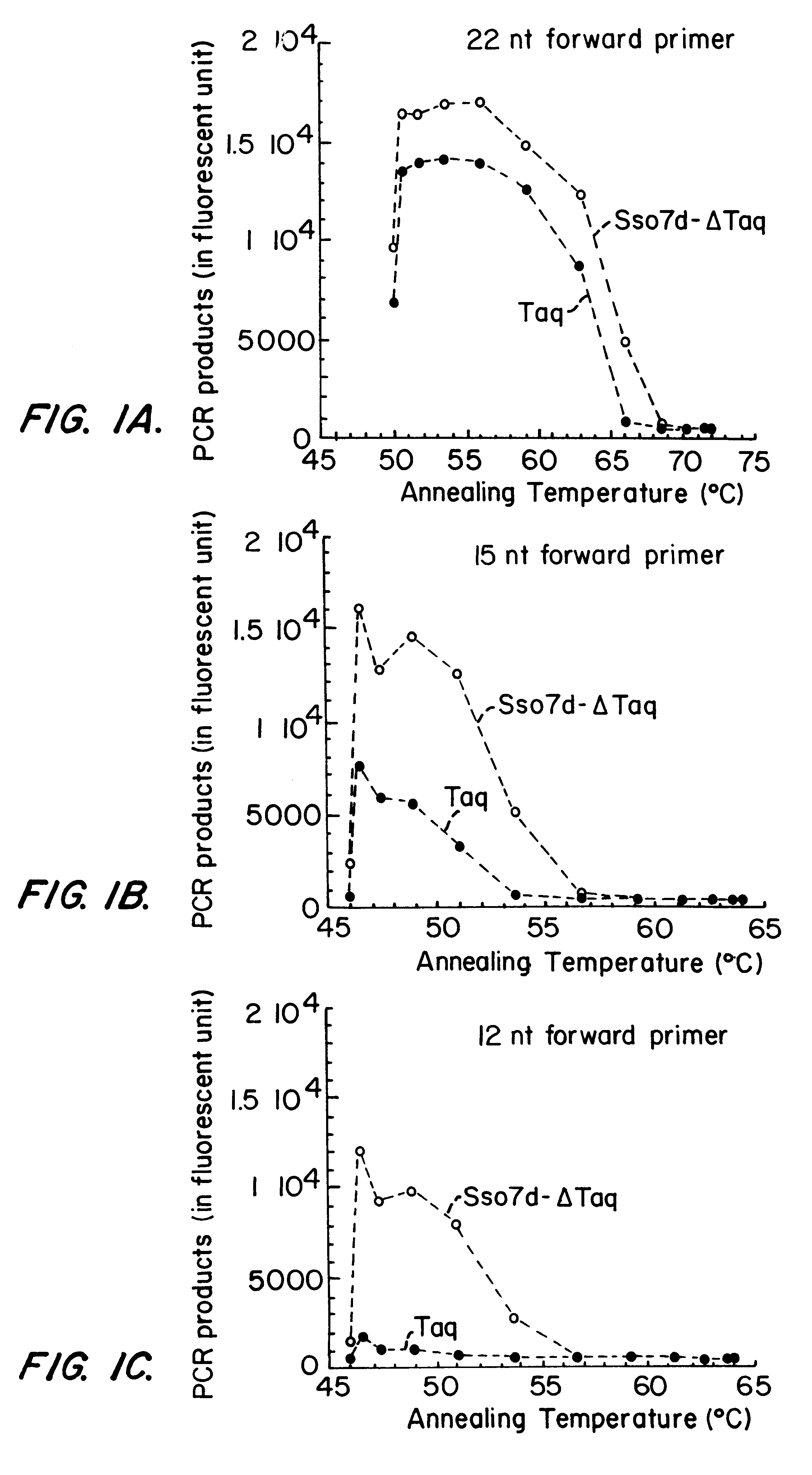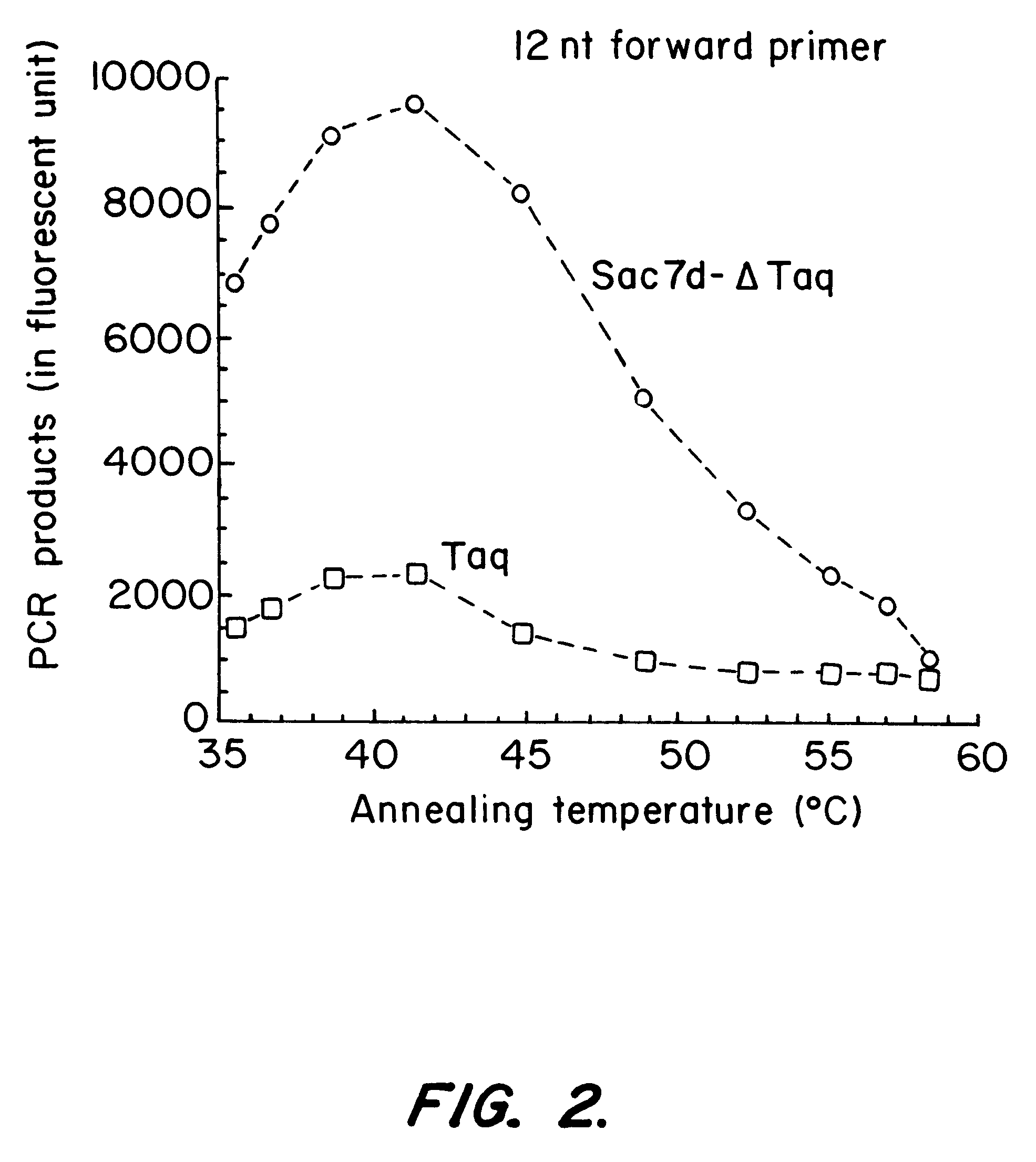Nucleic acid modifying enzymes
a technology lysine, which is applied in the field of nucleic acid modifying enzymes, can solve the problems of destabilizing the duplex structure, lysine binding tract that is a series of charged residues, and polymerase not enhancing processivity
- Summary
- Abstract
- Description
- Claims
- Application Information
AI Technical Summary
Problems solved by technology
Method used
Image
Examples
example 1
Construction of Fusion Proteins
Construction of Sso 7d-.DELTA.Taq Fusion.
The following example illustrates the construction of a polymerase protein possessing enhanced processivity, in which the sequence-non-specific double-stranded nucleic acid binding protein Sso7d is fused to the Thermus aquaticus PolI DNA polymerase (a family A polymerase known as Taq DNA polymerase) that is deleted at the N terminus by 289 amino acids (.DELTA.Taq).
Based on the published amino acid sequence of Sso7d, seven oligonucleotides were used in constructing a synthetic gene encoding Sso7d. The oligonucleotides were annealed and ligated using T4 DNA ligase. The final ligated product was used as the template in a PCR reaction using two terminal oligonucleotides as primers to amplify the full-length gene. By design, the resulting PCR fragment contains a unique EcoRI site at the 5' terminus, and a unique BstXI site at the 3' terminus. In addition to encoding the Sso7d protein, the above PCR fragment also enco...
example 2
Assessing the Processivity of the Fusion Polymerases
This example illustrates enhancement of processivity of the fusion proteins of the invention generated in Example 1.
Polymerase Unit Definition Assay
The following assay was used to define a polymerase unit. An oligonucleotide was pre-annealed to ssM 13mp 18 DNA in the presence of Mg.sup.++ -free reaction buffer and dNTPs. The DNA polymerase of interest was added to the primed DNA mixture. MgCl.sub.2 was added to initiate DNA synthesis at 72.degree. C. Samples were taken at various time points and added to TE buffer containing PicoGreen (Molecular Probes, Eugene Oreg.). The amount of DNA synthesized was quantified using a fluorescence plate reader. The unit activity of the DNA polymerase of interest was determined by comparing its initial rate with that of a control DNA polymerase (e.g., a commercial polymerase of known unit concentration).
Processivity was measured by determining the number of nucleotides incorporat...
example 3
Effect of Fusion Proteins on Oligonucleotide Annealing Temperature
This experiment demonstrates the increased efficiency of the Sso7d-.DELTA.Taq fusion protein, compared to Taq, to produce product at higher annealing temperatures by stabilizing dsDNA.
Two primers, primer 1008 (19 mer; T.sub.M =56.4.degree. C.) and 2180R (20 mer; T.sub.M =56.9.degree. C.), were used to amplify a 1 kb fragment (1008-2180) of the Taq pol gene. A gradient thermal cycler (MJ Research, Waltham Mass.) was used to vary the annealing temperature from 50.degree. C. to 72.degree. C. in a PCR cycling program. The amounts of PCR products generated using identical number of units of Sso7d-.DELTA.Taq and Taq were quantified and compared. The results are shown in Table II. The Sso7d-.DELTA.Taq fusion protein exhibited significantly higher efficiency than full length Taq at higher annealing temperatures. Thus, the presence of Sso7d in cis increases the melting temperature of the primer on the template.
The annealing te...
PUM
| Property | Measurement | Unit |
|---|---|---|
| temperature | aaaaa | aaaaa |
| temperatures | aaaaa | aaaaa |
| TM | aaaaa | aaaaa |
Abstract
Description
Claims
Application Information
 Login to View More
Login to View More - R&D
- Intellectual Property
- Life Sciences
- Materials
- Tech Scout
- Unparalleled Data Quality
- Higher Quality Content
- 60% Fewer Hallucinations
Browse by: Latest US Patents, China's latest patents, Technical Efficacy Thesaurus, Application Domain, Technology Topic, Popular Technical Reports.
© 2025 PatSnap. All rights reserved.Legal|Privacy policy|Modern Slavery Act Transparency Statement|Sitemap|About US| Contact US: help@patsnap.com


